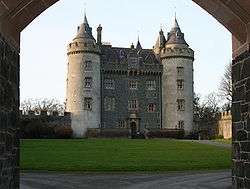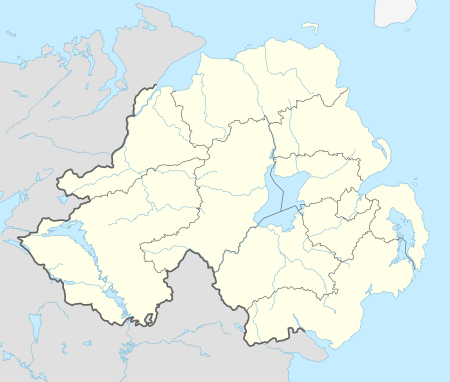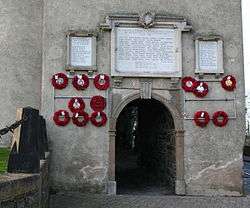Killyleagh Castle
Killyleagh Castle is a castle in the village of Killyleagh, County Down, Northern Ireland. It dominates the small village and is believed to be the oldest inhabited castle in the country, with parts dating back to 1180. It follows the architectural style of a Loire Valley château, being redesigned by architect Sir Charles Lanyon in the mid-19th century. It has been owned by the Hamilton family since the early 17th century.
| Killyleagh Castle | |
|---|---|
| County Down, Northern Ireland in United Kingdom | |
 Keep viewed from the gatehouse | |
 Killyleagh Castle Location within Northern Ireland | |
| Coordinates | 54°24′9″N 5°39′15″W |
| Type | Castle |
| Site information | |
| Owner | Private |
| Open to the public | Limited access |
| Site history | |
| In use | Late 12th century – present |
| Events | English Civil War |

It is currently the home of Gawn Rowan Hamilton and his young family. The castle hosts occasional concerts; performers have included Van Morrison, Glen Hansard and Bap Kennedy. The gate lodges provide self-catering holiday accommodation. From 2012 to 2014, the castle was used to film CBBC show Dani's Castle.
History
12th century
Killyleagh was settled in the 12th century by Norman knight John de Courcy who built fortifications on the site of the castle in 1180,[1] as part of a series of fortifications around Strangford Lough for protection from the Vikings.[2]
17th century
In 1602 Gaelic chieftain Con O'Neill of Clandeboye owned large tracts of North Down, including Killyleagh. O'Neill sent his men to attack English soldiers after a quarrel and was consequently imprisoned. O'Neill's wife made a deal with Scots aristocrat Hugh Montgomery to give him half of O'Neill's lands if Montgomery could get a royal pardon for O'Neill. Montgomery obtained the pardon but King James I divided the land in three, with the area from Killyleagh to Bangor going to another Scot, James Hamilton, later 1st Viscount Claneboye.[3] A map of Killyleagh from 1625 showed the castle as having a single tower on the south side of a residence.[1] In about 1625 Hamilton moved from Bangor to Killyleagh Castle,[4] where he built the courtyard walls.[2] It has been the home of the Hamilton family ever since.
Viscount Claneboye's son, James Hamilton, 1st Earl of Clanbrassil, built the second tower. He supported the Stuart monarch Charles I of England and the castle was besieged in 1649 by Oliver Cromwell's forces[1] who sailed gunboats into Strangford Lough and blew up the gatehouse. The Earl fled, leaving behind his wife and children. Parliament fined him for the return of the castle and his land.[2]
The 1st Earl's son, Henry Hamilton, 2nd Earl of Clanbrassil, rebuilt the castle in 1666. He erected the north tower and built (or perhaps restored) the long fortified bawn (wall) in the front of the castle.[1] The 2nd Earl's castle is mostly what remains today.
In 1667 the 2nd Earl married Lady Alice Moore, daughter of the Earl of Drogheda, and their only child died in infancy. Lady Alice discovered that her father-in-law, the 1st Earl of Clanbrassil, had stated in his will that should Henry die without issue the estate should be divided between five Hamilton cousins, the eldest sons of his five uncles.[5] She destroyed the will and had her husband make his own will in 1674, leaving the estate to her. Henry died of poisoning in 1675, then Lady Alice died in 1677, leaving the estate to her brother.[1][6] The cousins, however, were aware of the 1st Earl's will and pursued their rights as inheritors. The matter was concluded 20 years later when a copy of the original will was discovered. By then, the cousins were all dead. The last to die was James Hamilton of Neilsbrook, County Antrim, son of Archibald Hamilton, the next brother of James Hamilton, 1st Viscount Claneboye. James Hamilton of Neilsbrook had been confident of a settlement in his favour and had bequeathed the estate to be divided in two, with one half going to his daughter Anne Stevenson, née Hamilton, and the other half to his younger brothers Gawn and William Hamilton. In 1697 the probate court divided the castle, with Gawn and William gaining the main house and the two towers and their niece Anne receiving the bawn and gate house. Gawn and William had to open a new entrance on the north side in order to enter their castle.[1]
18th and 19th centuries
William died without children in 1716 and the castle passed to successive generations of Gawn Hamilton's descendants. Gawn's great-grandson Archibald Hamilton Rowan, an Irish nationalist of the United Irishmen, lived in the castle as one of his homes between 1806 and 1834 after his return from exile in America.
Hamilton Rowan's grandson, Archibald Rowan-Hamilton, and his wife employed architect Sir Charles Lanyon from 1850 to renovate the castle,[1][2][7] creating its romantic silhouette with the addition of the turrets.
James Hamilton of Neilsbrook's daughter Anne married Hans Stevenson and her estate passed to her son James Stevenson, then to his daughter Dorcas, later Dorcas Blackwood, 1st Baroness Dufferin and Claneboye (1726–1807), and on to Dorcas's great-grandson Frederick Temple Blackwood, 5th Baron Dufferin and Claneboye (1826–1902). In 1860 the 5th Baron gave the bawn and gate house to the Hamiltons and commissioned a replacement gate house to better match the main castle.[1] The Baron added Hamilton to his surname just before marrying his distant cousin Hariot Georgina Rowan-Hamilton, daughter of Archibald Rowan-Hamilton, in 1862.
20th century
The castle came under attack by the Irish Republican Army during the troubles of the 1920s. Gawn Rowan Hamilton has said: "I have a cutting from the Belfast Telegraph which tells the story of my great-great uncle being woken at 2 am and exchanging gunfire from the battlements, which was terribly exciting."[2]
Architecture
The architecture of the castle has no traces of an Irish tower house or castle. Benjamin Ferrey created a baronial gatehouse to match the two surviving corner towers to the castle. Lanyon's imposing doorcase was a celebration of Rowan-Hamilton's access through their front door for the first time in almost 200 years. The heavy plasterwork is by Mr. Fulton. Drawing room, dining room and library interconnect and look south into the garden. Lanyon retained the vaulted rooms in the northern circular tower and the pentagonal rooms in its Georgian counterpart. He re-encased the entire exterior while respecting the original fenestration. At roof level he provided a flurry of candle snuffers.[8]
References
- "History of Killyleagh Castle Archived 25 May 2010 at the Wayback Machine". Irish Secrets. Retrieved 28 March 2009.
- "King of my castle". The Belfast Telegraph, 28 July 2006. Retrieved 21 March 2009. Reproduced at Welcome to Killyleagh Archived 20 August 2009 at the Wayback Machine. Retrieved 21 March 2009.
- "The Settlement Story. Part three: Jailbreak, Rivalry and Plot!". Hamilton & Montgomery Settlement 1606. Ulster-Scots Agency. Archived from the original on 5 July 2008. Retrieved 22 March 2009.
- "The Settlement Story. Part six: Three Ulster-Scots Spiritual Revivals, the Death of Montgomery and the "Eagle Wing" sets sail". Hamilton & Montgomery Settlement 1606. Ulster-Scots Agency. Archived from the original on 5 July 2008. Retrieved 22 March 2009.
- Burke, John (1833). A Genealogical and Heraldic History of the Commoners of Great Britain and Ireland. Bentley. p. 348.
- "Ghost in the castle Archived 21 August 2009 at the Wayback Machine". Down Recorder, 27 October 1977. Reproduced at Welcome to Killyleagh. Retrieved 29 March 2009.
- O'Neill, B (ed). (2002). Irish Castles and Historic Houses. London: Caxton Editions. p. 18.
- Jeremy Williams, Architecture in Ireland 1837-92
| Wikimedia Commons has media related to Killyleagh Castle. |